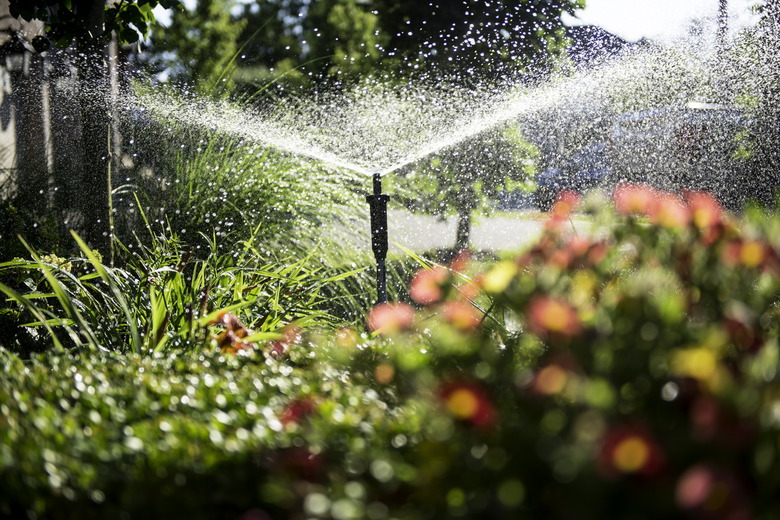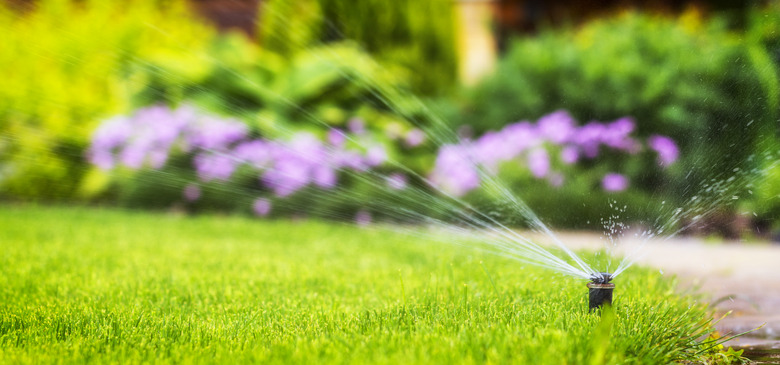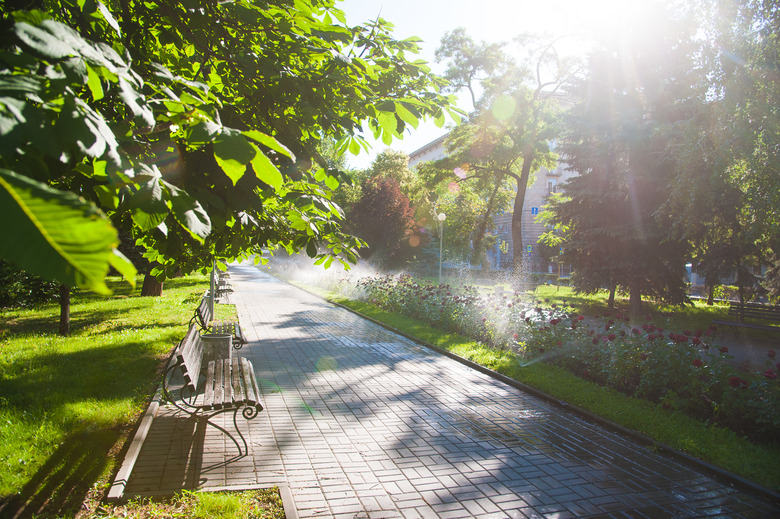How Does An Automatic Sprinkler System Work?
We may receive a commission on purchases made from links.
If you have an automatic sprinkler system installed in your yard, you should have a good understanding of how sprinkler systems work so you can address problems when they occur. A sprinkler system malfunction can waste a lot of water or, conversely, cause the death of plants and grass from lack of water (or too much water). On the other hand, if you don't have an automatic irrigation system, you might be surprised at how elegant and easy to install most systems are and thus decide to install one. However, it should be noted that the amount of digging involved pretty much disqualifies this as a DIY project, so you should look for a qualified pro to do the job.
Like a hose and nozzle, a sprinkler system draws water from the home's water supply and relies exclusively on the existing water pressure. Instead of a flexible hose, a sprinkler system relies on a network of buried rigid pipes, usually made from PVC, and instead of a nozzle, it distributes water through sprinkler heads, of which there are many types. Control valves and a backflow preventer round out the list of sprinkler system components, and the valves are what makes an automatic sprinkler system automatic.
Tip
An automatic sprinkler system relies on a network of underground pipes connected to 24-volt diaphragm valves that are controlled by an electronic control panel. When one of the valves gets the signal to open, water flows through the valve (at standard household water pressure) and into a network of branch pipes to the sprinkler heads.
The Water Supply and Backflow Preventer
The Water Supply and Backflow Preventer
Like a garden hose, a sprinkler system can be hooked up to any outdoor spigot on the property, but it's most common to permanently connect a sprinkler system to the household water supply and include a dedicated gate valve or ball valve as a main shutoff valve. A ball valve is the better choice because it's easier to control, shutting off with just a quarter turn on the handle, and it lasts longer. The main water valve allows you to turn off the water to service the sprinkler system without having to turn off the main water supply for the house, so it's an essential component.
Attached near the main shutoff valve, a backflow preventer is another must-have that is usually required by local ordinances. It's a vacuum breaker or antisiphon valve that allows water to flow in one direction only. It's there to prevent contamination of the water supply by debris (or possibly lawn chemicals) sucked in through the sprinkler heads by a large leak or other event that causes a pressure drop in the water pipes. If there is negative pressure in the municipal system, which can happen when firefighters tie into a nearby hydrant or a leak occurs in a water main, the backflow preventer stops water from being siphoned backward into the system and potentially contaminating the water in your home as well as in other homes nearby.
The Sprinkler System Manifold
The Sprinkler System Manifold
Often but not always located close to the main water valve, the manifold for an automatic sprinkler system is usually inside a buried valve box with a removable lid. The water pipe from the main water valve, which is usually 3/4-inch PVC, enters the valve box and is split into several branch lines by gluing on a number of PVC tees or installing a store-bought manifold. Each branch line delivers water to a different part of the yard, which is known as a "zone" in sprinkler parlance, and a system in a large property may have several manifolds distributed around the landscape.
The manifold ports each accept a short length of pipe that supplies the control valve for that zone. Another pipe extends from the valve outlet to tie into the underground pipes that deliver water to the sprinklers for that zone. The installation of the pipe system and the sprinkler heads requires some planning because the flow of water from each zone shouldn't overlap the flow from any other, which would waste water and deliver too much water to plants in the overlapping area.
How Valves Make Sprinkler Systems Work
How Valves Make Sprinkler Systems Work
Sprinkler system control valves run on 24-volt electricity, so there is usually a standard 120-volt exterior outlet installed nearby into which the transformer for the sprinkler system is plugged. The transformer feeds an electronic control panel with a station for each watering zone, and each station can be programmed independently. Each station has a pair of electric terminals for the two wires that come connected to the solenoid of the sprinkler valve that controls the flow of water for that zone.
Inside the valve, water flows under pressure to a rubber diaphragm that separates the inflow and outflow ports, and a tiny hole in the diaphragm allows water into an upper chamber, which keeps the pressure on both sides of the diaphragm equal and the diaphragm closed. However, there's another small passageway from that chamber to the outflow port, which is covered by a small piston.
When power is supplied to the solenoid, it lifts the piston, creating a pressure imbalance that opens the diaphragm, and water starts to flow. When the power is cut, the piston closes, the pressure equalizes, the diaphragm closes and the water stops. Most valves have a manual override control that allows you to open the valve by turning it counterclockwise. This allows you to make repairs without having to use the electronic control panel, which could be located far from the manifold.
Sprinkler Heads Do the Watering
Sprinkler Heads Do the Watering
When the valve controlling the network of pipes that forms one of the watering zones of an automatic sprinkler system opens, water flows though the pipes at the same pressure it flows through the main supply pipes in the house and exits through the sprinkler heads. These days, most sprinkler heads are pop-ups. They are recessed inside the sprinkler body below ground level when the water is off, and when the valve opens, water pressure forces the head to rise and start spraying water.
Some sprinkler heads deliver water in a fixed pattern with an arc from 15 to 360 degrees, while others rotate through an arc pattern and deliver water in the pattern in which the head rotates. Fixed heads deliver water more evenly but typically over a much smaller radius than rotating heads, and for irrigating very large areas, an above-ground impact rotary head is usually best. A residential sprinkler zone can include one, two or all three types of sprinkler heads to ensure uniform coverage.
Making Sprinkler Systems Work Efficiently
Making Sprinkler Systems Work Efficiently
Once an automatic sprinkler system has been set up and all the sprinkler heads have been adjusted for uniform watering, the sprinkler system is only as good as its programming. Most sprinkler control panels allow you to set the number of times per day or week that each zone comes on as well as how long it stays on during each cycle. Part of good planning is to include plants in each zone that have more or less the same watering requirements so none get too much or too little water.
A sprinkler system wastes water if it comes on right after a heavy rain, so a good addition to the system is a rain sensor that interrupts the watering program when it detects a preset amount of rainfall. Rain sensors are inexpensive and easy to wire into the control panel, and they not only save water, which is a precious resource everywhere, but they prevent your lawn, flowers and vegetables from being overwatered, which can increase the likelihood of fungal diseases and rot.
Another way to increase the efficiency of your sprinkler system is to add drip components for plants that need deep watering but can't tolerate water on their leaves. It's easy to connect drip lines to sprinkler valves with adapters, and you should be sure to add a filter to prevent the delicate drip emitters from getting clogged by impurities in the water.


